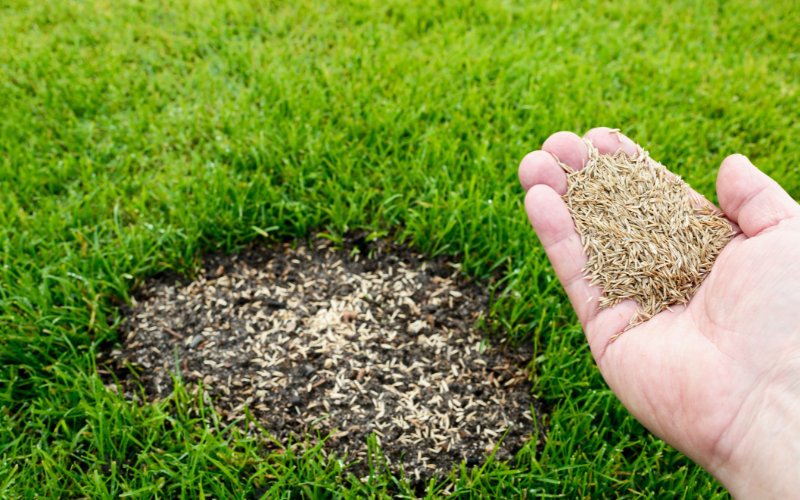If you have overseeded your lawn, you are probably wondering when you can start mowing. Well, this all depends on how the grass is doing. So before you head to the shed for the mower, you will want to inspect the new grass to make sure it’s ready and that your mower isn’t going to cause any damage. Let’s take a look at the different signs to check for so you can determine how long to wait to mow after overseeding.

How Long to Wait to Mow After Overseeding? (The Short Answer)
It can take up to four weeks for seeds to germinate successfully and sprout. Factors that can affect this are seed variety, weather, moisture content, and nutrient levels in the soil. Variations of these factors can affect how long it takes a root to establish and take hold, therefore determining when you can start to mow.
When to Mow After Overseeding? (Watch for These 2 Signs)
Now that your grass seeds are starting to grow and form your new lawn, you’ll need to carry out a couple of inspections and tests to determine when to mow after overseeding. Let’s take a look at what these are.
Blade Growth
The first item to check with your newly seed lawn is the actual height of the new blades. First, you want to make sure that the grass has grown long enough that it actually needs cutting.
After waiting so long, it can be tempting to head out with the mower because the lawn is starting to look a bit messy. But unless the new shoots are at least 3 ½ to 4 inches tall, you’ll need to wait. Overseeded lawns like Bermuda, Buffalo, and Kentucky Bluegrass can take four weeks to shoot and, in some cases, up to eight weeks. So, you’ll need to be patient.
Root Growth
The next item on our list to figure out when to mow after overseeding is root growth. Just because the blade is doing well doesn’t always mean that the root is established enough to take the forces of a lawn mower.
So, grab a handful of the new grass and tug at it. You’ll want to make sure that no grass comes loose from the soil. You are basically mimicking the forces of your lawn mower.
If you find that the grass is still loose and the roots still need time, give the lawn a few more days, then recheck.
Your First Mow After Reseeding – A Few Rules to Follow
How long to wait to mow after overseeding? Well, before you jump on your lawn mower, there are a couple of items you’ll want to check to make sure that conditions are right. If everything looks ok, you should be ready to mow. So, let’s take a look at these items.
Moisture in the Soil
To give your lawn a good start, you should have been watering a couple of times a day. So, if you are still following this watering schedule, your lawn’s soil is probably very soft. If you head out with a heavy lawn mower, like a ride-on or zero-turn lawn mower, on very moist soil, you’ll end up sinking and causing some pretty extensive damage to the newly germinated lawn.
Check the soil before you head out with a lawn mower so that you don’t end up causing any damage by sinking into the soil.
Checking if the Grass is Wet
It’s never a good idea to cut wet grass, this is especially true when it comes to new shoots. Lawn mower blades are much less effective when they try to cut wet grass, and the blades end up tearing the grass.
Even though it’s not ideal, this isn’t a huge problem for established grass as the plant can usually take the stress. But new shoots are not strong enough to take the extra stress of wet cutting.
So, check the weather and make sure you pick a dry day. Also, mowing later in the day is a good idea so that the morning dew has a chance to burn off.
What Happens If You Mow Your Lawn Too Soon After Reseeding?
Deciding how soon you can mow after overseeding makes all the difference in your lawn’s future. If you mow the lawn too early, it will cause some damage that the lawn will not come back from.
Now, this doesn’t necessarily include all the lawn, but it does cover those areas which are not ready. Small shoots are very delicate and don’t even like to be walked on, and definitely don’t like to be mowed.
The weight on the new shoot will basically crush them to the point that will prevent them from springing back. Also, the suction that a lawn mower creates in the cutting deck is forceful enough to pull the shoots out of the ground or at least enough to damage the roots.
Before you cut grass after overseeding, keep checking your new lawn to ensure both the blades and roots are ready. So, if you’re still wondering how long after overseeding can I mow, then my best advice is to be as patient as possible.


Leave a Reply